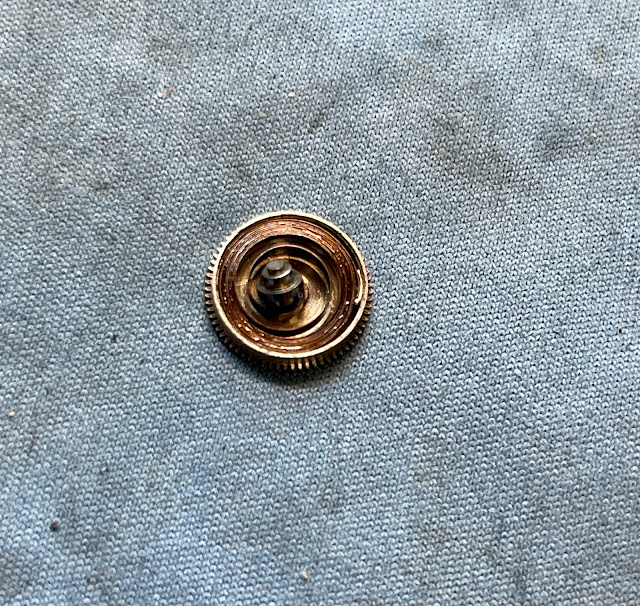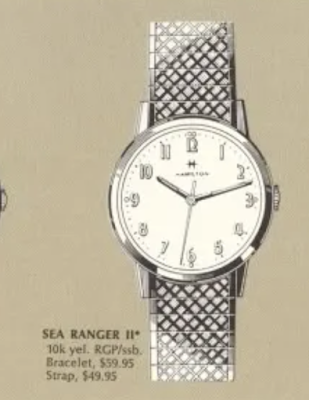Arguably my favorite genre of Hamilton watches are the military examples from WWII. There are a lot of different models and Hamilton even made watches for allies of the United States. Hamilton made pocket watches, wrist watches, chronographs, chronometers, elapsed time clocks, you name it.
Information about vintage Hamilton watch repair, restoration, models, and advice for collecting and collectors
Welcome
Greetings!
Monday, February 20, 2023
WWII Naval Aviators Watch model 39108
Some of the hardest to find (or expensive) models to find are the ones made for Canada and Russia. You'll see them come up for sale from time to time though. The most ubiquitous models are the Ord Dept watches made for the US Army, show as the Fire Control Wrist Watch below.
As a Navy veteran I especially like the models made for the US Navy, either for the Bureau of Ships (BUSHIPS) or the watches for naval aviators, either in the Marine Corps or the US Navy.
My project watch came courtesy of the original owner's son. The original owner flew PBYs with the Navy and I would wager that he probably knew my wife's maternal grandfather, who was navigator on PBYs in the Pacific.
As received, the watch appears to be well used but also well cared for. The crown has been worn through the chrome and well into the brass. The crystal is so cloudy that most of the details are lost to haze.
The back of the watch is also well-worn. The case back is stainless steel but the case is chrome plated brass. It's not unusual to see a lot of wear to the edges of the case while the case back is still sound.
Hamilton military watches used cases by Wadsworth, Star and Keystone case makers. The 39108 uses a case made by Keystone. The KH3 on the outside of the case back indicates Keystone and the inside of the case back is even more clearly marked.
Behind the case back is a dust cover that pops onto the movement ring that secures the movement to the inside of the case. Surrounding the dust cover is a gasket to help keep the watch water-tight. There's also a gasket in the stem tube - although those are usually no longer secure after 80 years.
The 39108 uses a 987S movement. This caliber is very similar to the 987A with the addition of a large sweep wheel on the 3rd wheel and a small seconds pinion that goes through the center wheel. The pinion is held by a keeper secured with two screws as shown below.
With the cloudy crystal out of the way you can see the details of the dial. This dial is original as you can clearly see by the Hamilton brand on the dial. This engraving would likely be lost if the dial was refinished.
Notice also the hour and minute hands are stainless steel. This is a critical detail to look for with a US Navy watch. The watches for the Marine Corps would have a white dial, as shown in the catalog info above. The hands would be the traditional blued steel.
You are well-advised to use a special lifter to remove the large sweep wheel. It has differing ends that allow you to engage the wheel at the center and lift it straight off the pinion. You don't want to damage the long pinion on the 3rd wheel or your second hand won't work correctly.
As you can see, the sweep wheel has 5 spokes so one end of the lifter straddles a spoke while the other engages a clear section of the wheel.
The hard part is now out of the way. Next I'll remove one of the two screws keeping the sweep pinion in place and move the keeper out of the way so I can lift the pinion out.
The 987S was Hamilton's first hacking wrist watch movement. That means there's a small mechanism that will stop the watch by gently engaging the balance when you pull the crown out to set the time. You can see the J-shaped spring that will "hack" the watch.
The mainspring inside the barrel is an old blue steel example. Although it's still well lubricated, I'd wager it has set in place and lost most of it's potential energy.
Yup - called it. I'll replace it with a fresh white alloy "lifetime" spring.
My ultrasonic cleaner shook a screw loose from the balance. These timing screws are tiny. Without this screw attached the balance would tick wicked fast. I need to put it back in it's proper place to keep the balance poised. Can you tell where it should go?
To handle tiny screws like this you really need a small pin vise. A pin vise holds the screw so you can get it started and then you can tighten it with a screwdriver. The screws in the balance are symmetrical with the balance arm, so I know the missing screw goes next to the balance arm in the open spot.
Okay, everything is cleaned and ready to get put back together. It's all noticeably shinier now that it's been through the ultrasonic for 20 minutes.
The balance is reinstalled and the watch is now ticking away with a good motion. I'll put it on the timer before I reinstall the sweep wheel parts. That way I know if there's an issue with them. At this point the movement looks like a garden variety 987A.
Not too shabby but I can slow it down easy enough.
A very slight adjustment to the regulator brings the beat rate right in line.
The sweep wheel and the pinion can go on next. Then I'll reinstall the dial and hands.
The movement goes back into the case and I installed a fresh crown as well.
The dust cover snaps on and then the gasket is pressed into place. Lastly I'll screw the back cover into place and the watch will be complete.
I installed a vintage canvas strap and this 80 year old watch is now looking and running fantastic. Now you can see why these are my favorite watches.
Wednesday, February 8, 2023
1966 Sea Ranger II
Have you ever noticed someone who you don't know but who looks so familiar that you wonder if you don't really know them after all? Some people just have one of those faces.
The same is true with watches. There are some models that look a lot like other models and you have to scratch your head to figure out what it is. A good example is the 1966 Sea Ranger II. It was made for four years but it wasn't until recently that I actually saw one first hand.
The Sea Ranger II has an all numeral dial and you'd definitely spot it as a "Sea Something". It looks a lot like a Sea Crest III, or a Seaman, or Seaman II, or Sebold. In fact, it looks the most like a 1964 Sebold but all of these Sea-models came in stainless steel cases. The Sea Ranger II has a 10K yellow RGP case with a stainless back, and that's what makes it unusual. You could purchase it in 1966 for just shy of $40 and that made it one of the least expensive models in the Hamilton line up. That's about $360 in today's dollars - a real bargain by modern mechanical watch standards.
My project watch arrived in typical "as found in a drawer" condition. It's well worn but should clean up nicely.
The bracelet that came on the watch is not original but the package did include the original bracelet made by JB Champion. Unfortunately it has a broken rivet and is in need or repair. It shows quite a bit of wear too but it would be better to repair the bracelet and install it rather than use the one-size-fits-all bracelet currently on the watch.
Like many of the Sea-somethings, the Sea Ranger II has a 17 jewel 688 movement inside. This caliber is the grandfather of Hamilton's current manual winding movements made by ETA. There's a very strong family resemblance to the Calibre 2804-2 used in today's Khaki Field Mechanical
You couldn't tell through the beat up crystal that the Sea Ranger II's dial is actually textured. This would be a very difficult, dare I say impossible, dial to refinish correctly. Fortunately it's still in excellent shape.
Everything is cleaned and ready to be reassembled.
It took me quite a while to get it to run smoothly and to dial in the beat error and beat rate but it's looking solid now.
A new crystal and a thorough cleaning made a world of difference on this watch. It may be "plane jane" by most people's standards but it's got a timeless style that many other models emulate.
Subscribe to:
Comments (Atom)
































